Canada and the War in Asia and the Pacific
Overview of Canadian Efforts in Asia
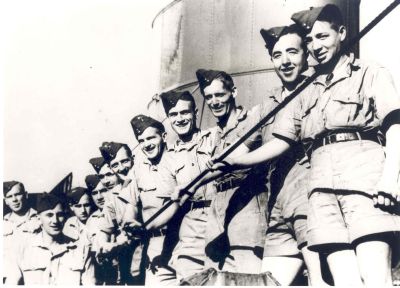
The First Canadian contingent lands at Hong Kong.
Canadian forces were involved in the war in Asia from its outset. The fighting in the Pacific did not begin only with the Japanese surprise attack on Pearl Harbor on December 7, 1941; at the same time other Japanese forces attacked the British colonies of Hong Kong and Malaya (now Malaysia) as well as several other American bases in the Pacific. In Hong Kong, the small British garrison included 1,975 Canadians.
They were members of two infantry battalions - the Royal Rifles of Canada from Québec and the Winnipeg Grenadiers - and they had arrived in Hong Kong only three weeks before as part of an attempt to strengthen the island colony's defences. When the Japanese army attacked in overwhelming numbers, the beleaguered garrison fought without any realistic hope of success. Nevertheless, the Canadians fought courageously, and one of them, Company Sergeant-Major John Osborn of the Winnipeg Grenadiers, was awarded a posthumous Victoria Cross after he deliberately fell on a grenade just before it exploded, thereby saving the lives of several comrades. The Canadian commander, Brigadier John Lawson, was killed fighting in front of his command post. Finally, on Christmas Day 1941, the Allied forces in Hong Kong surrendered.
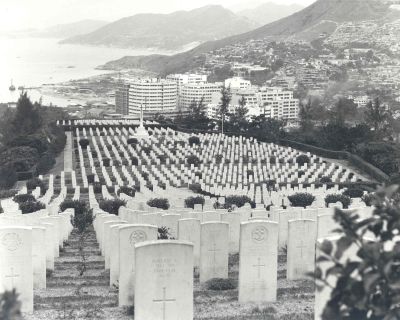
Sai Wan Bay War Cemetery, Hong Kong, where 283 soldiers of the Canadian Army are buried, including 107 who are unidentified.
Two hundred and ninety Canadians died in the hard-fought battle, but as the remainder surrendered they could not have seen that their horror was just beginning. They were to remain prisoners for almost four years, during which time they were subjected to systematic brutality that found its equal only in the concentration camps. Forced to carry out backbreaking labour on construction sites and in mines while being beaten frequently and fed a starvation diet, 264 more young men died before the emaciated and diseased survivors were freed in 1945. The majority of those who returned to Canada suffered serious disabilities as a result of their prisoner of war experience, and many died premature deaths.
The Royal Canadian Air Force (RCAF) was also involved in the war in Asia from the beginning. In the early part of the war, many members of the quickly expanding RCAF were assigned to Royal Air Force (RAF) squadrons and went wherever those squadrons were sent. This resulted in several hundred Canadians serving with the British forces as they fought against the rapidly advancing Japanese forces in Malaya, Singapore, Java (now Indonesia), Burma (now Myanmar) and India.
However, it was a Canadian squadron that was next to play a key role in the war against the Japanese. As the Japanese extended their domination in the Pacific, the enemy threat soon reached as far as Ceylon (now Sri Lanka) off the southeast coast of India. In March 1942, the RCAF's 413 General Surveillance Squadron was dispatched with its Consolidated Catalina flying boats from Scotland to Ceylon. The commander, Squadron Leader Leonard Birchall, arrived there on April 2. Two days later, on his first patrol, he detected the Japanese fleet streaming towards the island. His radio operator managed to send off a warning message before the Catalina was shot down by Japanese fighters. Although three of his crew were killed when the Japanese machine-gunned the airmen in the water, Birchall and the remaining crewmen were taken prisoner. They did not know until after the war that their hurried message had resulted in the island's defences being ready when the Japanese attack came. The effective defence, combined with the American naval victory in the Battle of the Coral Sea a few weeks later, meant that the Japanese never threatened that part of Asia again. Birchall and his crew became known as "the Saviours of Ceylon."
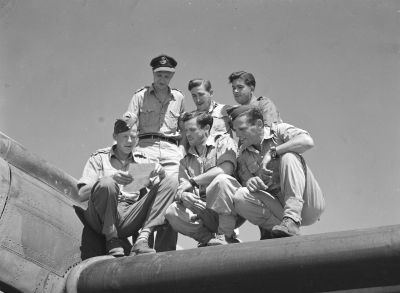
The Canadian transport squadrons on the Burma front numbered six men from Powell River, British Columbia, pictured together reading news from home.
After the war, Birchall was decorated not only for his distinguished flying but also for his courage and leadership in resisting his Japanese jailors during years of imprisonment.
In the spring of 1942, the Japanese were also expanding their area of influence towards North America. In June 1942, their forces landed on the islands of Attu and Kiska in the Aleutians off the coast of Alaska, and on June 20 a Japanese submarine shelled Estevan Lighthouse on the west coast of Vancouver Island, causing minor damage.
Although the Japanese in the Aleutians were still 3,000 kilometres from Vancouver and the attack on the lighthouse was little more than an act of bravado, the threat could not be ignored. Canada committed two army divisions and considerable air and naval forces to the defence of the West Coast, and the Americans rushed reinforcements to Alaska. There was no road link between that region and the rest of the continent, so the Americans began a high priority program to build one. During the next year, tens of thousands of construction troops laboured to cut the Alaska Highway through thousands of kilometres of virgin forest. By the time it was completed, the enemy threat had receded, but the road has remained an essential transportation artery for both Canadians and Americans to this day.
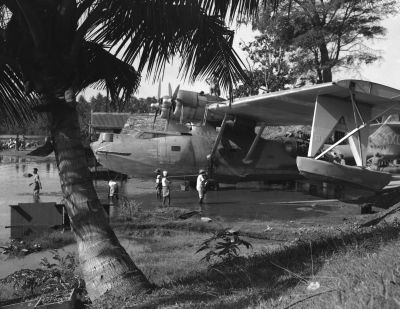
A Consolidated "Catalina" flying boat undergoing repairs at the Royal Canadian Air Force base in Ceylon, India. It was a plane from this squadron which first spotted Japanese warships attempting to attack a strategic section of the Indian Empire.
In 1943, the Americans launched a campaign to retake Attu and Kiska, and Canada provided an infantry brigade, troops for the combined American-Canadian Special Service Force, and naval and air forces. The Japanese fought to hold Attu, but when the Canadian-American force landed on Kiska, they found that the island had been abandoned days before.
In 1943-44, the British Fourteenth Army turned the tide in northern Burma and eastern India in a series of hard-fought battles, and many individual Canadians fought with the British army and air force during these operations. One was Major Charles Hoey Duncan, B.C., who had joined the British Army in the mid-1930s. In Burma in February 1944, Hoey led his infantry company in an assault on a hill held by the Japanese. He was killed, but his gallantry earned him the Victoria Cross.
In the air, Canadian Pilot Officer H., Armstrong, flying Hurricanes with the RAF's 185 Squadron, shot down three Japanese bombers and assisted in the destruction of a fourth in just three days in March 1943.
The British found that the American B-24 Liberator was an effective long-range bomber in Asia, and soon had several squadrons of the huge planes operating there. Many members of these units came from a Canadian training station in British Columbia. To this day, these veterans call themselves the "Burma Bombers."

The HMCS Uganda, the only Canadian warship to fight against the Imperial Japanese Navy.
In November 1944, the Allies began the campaign to push the enemy out of India and Burma. This involved attacking over a mountain range and then dFown into the jungles of Burma itself. There were no roads over the mountains, so British General Sir William Slim came up with a then-novel solution. The entire army was to be supplied by air. To do this, he needed large numbers of supply aircraft capable of landing on dirt airstrips just behind the lines, or even parachuting supplies onto the front lines themselves.
Included in this air armada were Canada's 435 and 436 Transport Squadrons flying twin-engined Dakotas. The two squadrons flew right up to the edge of enemy territory carrying troops, ammunition and food. They were frequently fired at from the ground, and two Dakotas were shot down by Japanese fighters.
Canadians were involved in other special groups in Asia, such as the "Sea Reconnaissance Unit," a group of frogmen who spearheaded the British Army's assaults across the rivers of Burma. Lieutenant-Commander B.S. Wright led the unit and Flight Lieutenant G.H. Avery earned the first Military Cross ever awarded to a frogman, for bravery in the assault crossing the Irrawaddy River.
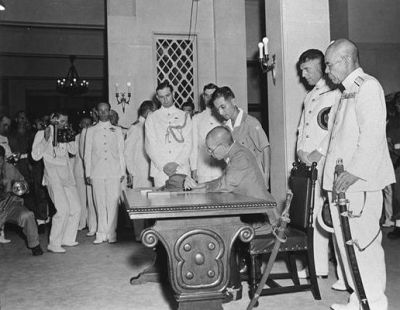
Japanese surrender ceremony. Lt. Gen. Tanaka signs surrender document while Vice Admiral Fujita waits his turn, Government House, September 15,1945.
Another special group included 40 Japanese-Canadians and Chinese-Canadians who volunteered to fight in Asia. Their language skills were of great benefit to the Allies as they worked as interpreters with intelligence units or with the secret "Force 136" teams that went behind enemy lines and worked with guerillas to harass enemy supply lines. Several of them were decorated for their actions, and their service was a major factor in influencing the Canadian government to grant Chinese and Japanese-Canadians full rights as Canadian citizens several years later.
After the war in Europe ended, the Allies began to concentrate their great military power in Asia and the Pacific. The first Canadian force to make its additional presence felt was the Royal Canadian Navy, when the cruiser HMCS Uganda joined the British Pacific Fleet in time to participate in the Allied operations around Okinawa in the spring of 1945. The auxiliary cruiser HMCS Prince Robert, which had helped transport Canada's troops to the ill-fated defence of Hong Kong in 1941, returned to the Pacific theatre and had the satisfaction of assisting in the liberation of the prisoners of war in Hong Kong.
Canadian Merchant Seamen also served throughout this part of the world on ships of both Canadian and Allied registry. It may never be known how many Canadian ships sailed into the Pacific Theatre carrying the troops and cargoes essential to the successful conclusion of the War. However, their losses are known. The Merchant Navy Book of Remembrance records the deaths of seamen from the "Jasper Park", the "Fort Longueuil" the Lianash" and fourteen other ships which suffered direct attack from the Japanese.
During this period, a small group of Canadians were flying with the Fleet Air Arm off British aircraft carriers. On August 9, Lieutenant Robert Hampton Gray of Nelson, B.C., flew his Corsair divebomber off HMS Formidable to attack Japanese shipping near the Home Islands. He spotted a Japanese destroyer in Onagawa Bay and dove to attack. Although his aircraft was hit repeatedly by anti-aircraft fire, he continued his dive until his aim was certain. His bombs struck the ship amidships and it quickly sank. Gray crashed a short distance away, and was subsequently awarded a posthumous Victoria Cross.
Canada's involvement had now built up to the point where more than 10,000 Canadians had served or were serving in Asia and the Pacific. The RCAF alone had over 3,100 in the theatre in 1945.
Meanwhile, preparations continued for the Canadian contribution to the invasion of the Japanese Home Islands planned for the fall of 1945. A complete infantry division and several air squadrons were being readied - a force of more than 24,000. All preparation stopped when the atomic bombs were dropped on Japan, causing the Japanese to surrender unconditionally on August 15, 1945. The shock of this new instrument of war was mixed with the joy of peace and the knowledge that no more Canadians would have to die in one of the most terrible wars in history.
On September 2, 1945, the formal surrender documents were signed on board the American battleship USS Missouri in Tokyo Harbour. Colonel Lawrence M. Cosgrave signed on behalf of Canada, and the Second World War was officially over.
- Date modified: